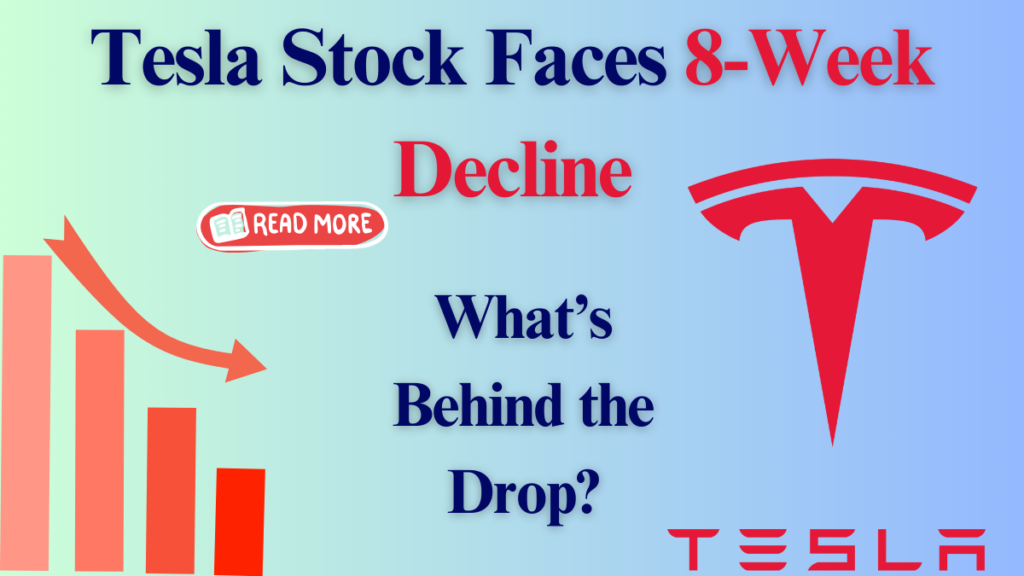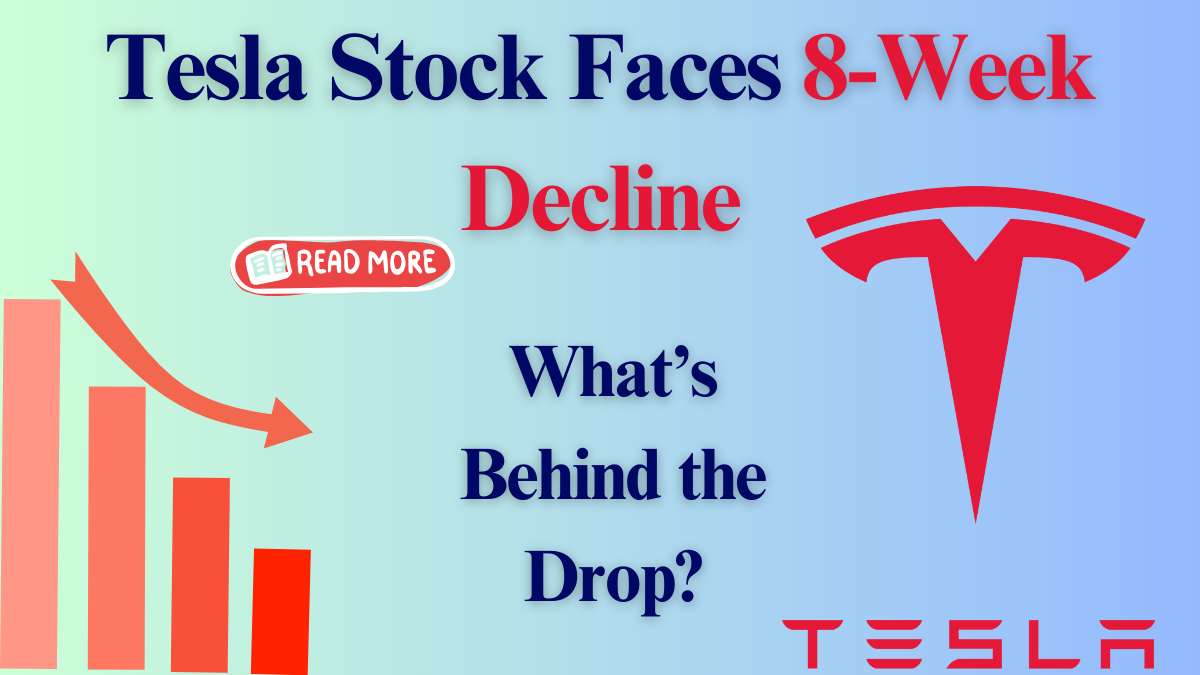Tesla’s stock has taken a significant hit, marking an 8-week consecutive decline in its value. As of March 2025, investors are questioning whether the ongoing drop is an overreaction or if there are deeper issues at play. Despite the company’s long-term prospects and Elon Musk’s continued leadership, there are several factors contributing to the dip in Tesla’s stock price. In this article, we’ll break down the reasons behind this downward trend and whether investors should be worried or see this as an opportunity.

Why is Tesla’s Stock Declining?
Tesla has become a staple in the stock market, drawing attention for its innovation in the electric vehicle (EV) sector, its ambitious plans for the future, and, of course, its outspoken CEO, Elon Musk. However, in recent weeks, Tesla’s stock has been on a consistent downward trajectory. Here are a few factors contributing to this decline:
1. Elon Musk’s Political Controversies
Elon Musk’s high-profile political views and controversial comments on social media platforms have been drawing increasing attention. Some investors worry that his outspoken nature could impact Tesla’s public image, potentially affecting sales or investor confidence. While Musk’s statements may not directly affect the company’s operations, the negative media coverage could create a ripple effect, especially if it dissuades potential customers or partners from aligning with Tesla.
2. Market Overreaction to Economic Uncertainty
Many analysts argue that the market’s reaction to Tesla’s recent stock movement is an overreaction. Broader economic factors such as interest rate hikes, inflation concerns, and overall market volatility have led to sharp declines in tech stocks, and Tesla is not immune. As one of the most high-profile growth stocks in the market, Tesla often experiences amplified fluctuations, especially in uncertain economic conditions. This has left some investors wondering if the current dip is a natural market correction or an unwarranted overreaction.
3. Challenges in Tesla’s Product Rollouts
Tesla’s ambitious plans for new vehicle models and technology are certainly exciting, but delays and production issues are not uncommon for the company. The market has been eagerly awaiting the launch of Tesla’s Robo-Taxi, which promises to revolutionize transportation and bring in significant revenue. However, the long-awaited launch has faced delays, and there are concerns over whether Tesla will be able to meet production expectations. If these delays continue, Tesla’s stock could suffer as the market revises its earnings expectations downward.
4. Rising Competition in the EV Market
As more automakers enter the EV space, Tesla is facing increasing competition. Traditional car manufacturers are rapidly ramping up their electric vehicle offerings, and new players are emerging with innovative solutions. While Tesla remains a leader in the industry, the growing competition could affect its market share and profitability, putting additional pressure on its stock.
Is Tesla’s Stock an Opportunity or a Risk?
The question on every investor’s mind is whether the ongoing stock drop presents a buying opportunity or if it’s time to exit Tesla positions. Here are a few perspectives on both sides:
1. Opportunity: The Long-Term Vision Still Holds
Despite the recent downturn, many investors believe that Tesla’s long-term vision still holds immense value. The company continues to lead in the electric vehicle market, and its autonomous driving technologies, energy solutions, and potential for Robo-Taxis are all part of a broader growth strategy. With a strong leadership team and an innovative mindset, Tesla could weather this short-term storm and rebound strongly. The dip in stock prices may represent a buying opportunity for those who believe in Tesla’s long-term growth potential.
2. Risk: The Uncertainty Could Persist
On the flip side, some analysts argue that Tesla’s stock may face further volatility in the short term, especially if Musk’s controversies continue to dominate headlines. Economic uncertainties such as inflation and potential regulatory challenges in different markets could also weigh on Tesla’s performance. If the market continues to sour on high-growth tech stocks, Tesla may face further headwinds, making it a riskier investment in the near term.
Tesla Stock Options Strategy: Hedging and Diversifying
For those looking to capitalize on Tesla’s stock fluctuations, there are several strategies that could help mitigate risk or profit from the volatility. Stock options, such as put and call options, could be used to hedge bets against further drops or take advantage of a potential recovery.
1. Buying Put Options for Protection
If you already hold Tesla stock and are worried about further declines, buying put options could offer protection. A put option allows you to sell your stock at a predetermined price, even if the market price falls lower. This strategy acts as insurance, providing a safety net if Tesla’s stock continues to dip.
2. Selling Covered Calls for Extra Income
If you believe Tesla’s stock may rebound in the long term, selling covered calls could be a strategy to generate additional income. This involves selling call options on Tesla shares you already own. If Tesla’s stock price rises above the strike price, you may have to sell your shares, but if it doesn’t, you keep the premium from the option sale.
3. Straddle or Strangle Strategy for Volatile Markets
For those who expect continued volatility, a straddle or strangle options strategy could be appropriate. Both strategies involve buying both put and call options on Tesla stock, profiting from significant price movements in either direction. This approach takes advantage of market fluctuations, regardless of whether the stock rises or falls.
Conclusion
Tesla’s 8-week decline has raised concerns among investors, but it is important to assess the broader picture. While short-term market reactions may seem dramatic, Tesla’s long-term growth potential remains strong. The company’s leadership in electric vehicles, its innovation in autonomous driving, and its upcoming product launches provide significant upside potential for those willing to wait out the volatility. However, given the ongoing uncertainties—both in terms of Musk’s personal controversies and broader economic factors—investors should remain cautious and consider diversifying their portfolios. For those looking to navigate the current turbulence, strategies like stock options could provide a way to manage risk and capitalize on potential price swings.
Frequently Asked Questions (FAQ)
Why is Tesla’s stock declining for 8 weeks straight?
Tesla’s stock has been affected by several factors, including Elon Musk’s political controversies, market volatility, delays in product launches, and rising competition in the EV market.
Is the drop in Tesla’s stock an overreaction?
Many analysts believe the market may be overreacting, especially considering broader economic uncertainties. However, the drop could also be a natural market correction in a period of high volatility.
Should I buy Tesla stock now?
The decision to buy Tesla stock depends on your risk tolerance and investment strategy. Some investors see the current dip as an opportunity, while others may wait for more stability or consider diversifying their investments.
What is the Tesla Robo-Taxi and how is it impacting the stock?
The Robo-Taxi is Tesla’s long-awaited autonomous ride-sharing service. Delays in its launch have raised concerns among investors about the company’s ability to meet production goals, which has contributed to the stock decline.
How can I hedge my Tesla stock positions?
Options strategies such as buying puts for protection, selling covered calls for income, or using straddle/strangle strategies to capitalize on volatility could be potential ways to hedge your Tesla positions.
Click here to learn more.
Pari is a passionate writer known for captivating stories that blend imagination and reality. Inspired by travel, history, and everyday moments, Pari crafts narratives that resonate deeply with readers.
